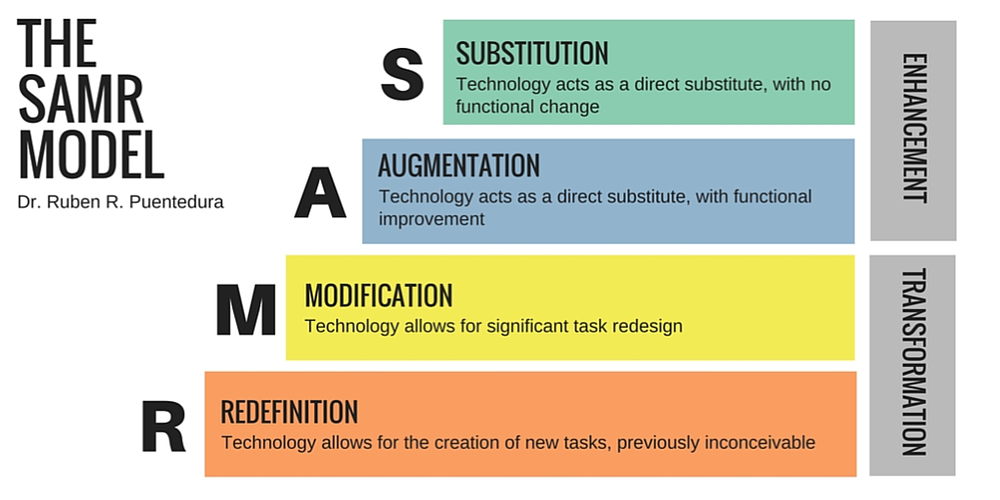As a graduate student in the mid 1980’s at Harvard, Dr Ruben Puentedura was examining the
undergraduate science program. He could see some of the tools that were available for digital
storytelling would be useful. But equally it wasn’t intrinsic to the tools being used, but really
different types of practices – how the tools were used in teaching.
This was the basis for his well known and popular teaching model – the SAMR Model.
An acronym that stands for different types of teaching practices in relation to the use of digital
technology.
These four practices are:
Substitution
At this stage, technology is directly substituted for a more traditional one. It is a simple, bare-
bones, direct replacement.
For example: Using the software on an interactive whiteboard or touchscreen to write up the notes for the class using the digital inking functions.
Augmentation
The technology is again directly substituted for a traditional one, but with significant enhancements to the student experience.
For example: Now being able to save & distribute those notes directly from the interactive display to all the students in the class, and even those who may have missed out. May include notes from a lesson, or even a document created using software with screenshots and annotations relating to the subject.
Modification
In this stage, you are beginning to move from enhancement to transformation on the model.
Instead of replacement or enhancement, this is an actual change to the design of the lesson and its learning outcome.
For example: By now integrating further collaboration hardware such as a VIVI, not only can a
teacher be writing & annotating on the board, and able to save the content, but students are able to view the lesson live on their devices in real time, and also present their screen. By using enhanced analytics provided by the VIVI, teachers are able to get data on individual student participation and a greater understanding of their progression.
Redefinition
The last stage of the SAMR model is Redefinition and represents the pinnacle of how technology
can transform a student’s experience. In this case, you ask yourself if the technology tools allow
educators to redefine a traditional task in a way that would not be possible without the tech,
creating a novel experience.
For example: Adding a video conferencing solution to a room will give the ability to take students on virtual experiences that may have otherwise been impossible. Take a tour of a spaceship guided by an astronaut, or choose from many other of the experiences available online on sites such as virtualexcursionsaustralia.com.au
By going one step further and adding in recording and streaming capabilities, teachers can record lessons for students to review.
Dr Puentedura says it is just fine for people to take their time incorporating elements of the model in their teaching practice. It’s important for them to feel comfortable and evolve. Do what you already do at the substitution and augmentation levels and incorporate it into your practice. When you are comfortable then you can move into the other parts of the model and bring in elements of Modification and Redefinition.
“to be honest with you, this is the approach that would work for most teachers” he says.
The team at DIB Audiovisual can work with you to integrate audiovisual products and solutions into this teaching methodology. We provide staff training and maintain a strong emphasise on
continued Professional Development with any systems we install. This is why our team is
considered to be professionals in what we do. For us, it is not just about the physical product, but the application in your teaching environment that counts.
The team and DIB Audiovisual have been excited to learn about the SAMR model as it is a natural to our existing consulting methods. We are firm believers in helping schools enhance their teaching through technology striking a balance that helps and provides for growth but does not force unproven or unwanted tools and methodologies onto teachers.
Call us on (03) 9457 4800 or use this link to find out more.


